Newsletter time again, and I am in the garden typing this bit, very out of range of the wi-fi. However if I lose this small segment it will be less important than if I start to work on the main body and lose that. The sun us warming up though, and so I will need to go in for cover, - and so must the slumbering sunbather beside me, formerly known as little nipper, but these days not so small
Before I forget, Saturday, today, is the final day of the Spring Postcard Fair at Woking. Postcards may not be part of your collection, but many tobacco and trade companies issued them, and you may well find them at Woking, if you know what you are looking for. And though it is worth going for many reasons, this year`s event marks the fiftieth anniversary of the Postcard Traders Association, and in honour of that admission is free of charge to everyone. So if it is close, or if you fancy a grand day out, why not nip along and see what you can find.
And if you cannot make it now, they also have an Autumn Fair, at the same venue, which is also free admission, for this year only. That will be on the 19th & 20th September 2025
So to our newsletter, and this week it went much better than last week, and I only had to change two days, Tuesday and Friday - and I also found replacements quite quickly. But we will talk of that later, let us start with ....
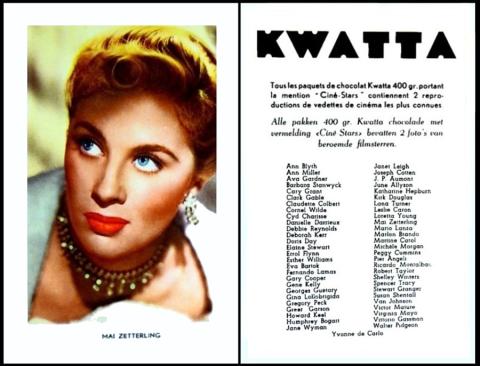
KWATTA [trade : chocolate : O/S] "Cine Stars" (1950s) Un/55
A centenary card ! To mark the birthday, today, in 1925, of Mai Elisabeth Zetterling, in Vasteras, Sweden.
You may only know her as a pretty, if wistful, beauty, but she also wrote novels, books and her autobiography, tracing her path from a simple, working class child to the lover of the rich and handsome film star Tyrone Power. She was also married twice, to a Norwegian actor from 1944 to 1953, with whom she had a daughter and a son, and then to the British author David Hughes, from 1958 to 1979, and it was he who encouraged her to publish her thoughts as books.
That journey began at the Royal Dramatic Theatre, the national theatre of Sweden, aged just seventeen. She freely admitted that the war had been good for her career, as many of the European actresses were German or Austrian, "on the other side" as it were, and, with her Swedish accent, she was able to pick up many of the roles that she would otherwise not have even been considered for.
By 1944 it is often said that she was famous enough that Ingmar Bergman wrote a film with her in mind. However it was actually his first screenplay, he was only still a teenager. It was a strange film, a young girl at a boarding school forms a relationship with another girl who is being abused by her lover. It was called "Hets", translated to "Torment" - and the director won the Grand Prize at the Cannes Festival for it, which also increased her fame.
Because of that, she was offered the title role in another film, to be made in England, called "Frieda". Released in 1947 it tells a tale which was something very pertinent - during the war an English soldier had been rescued by a German woman, and he decided to marry her and bring her home to England. Neither of them are in love with each other, but they stick together despite the fact that there is much opposition to her just for being German. There is also a twist, as her brother was much more involved with the whole German regime than she would like made public. It is a very good, and thought provoking film, even today.
She made several films in Britain, right up, almost, to her death, in 1994, aged sixty-eight.
What is less known is that she also operated behind the screen, as a director, making the very critically acclaimed "The War Game" in 1963. Some of her films were rather too free in their morals to gain public acceptance, but she was European, things were more openly discussed there. There was also a definite feminist theme, which did not sit well with the more masculine world of the time.
According to the Trading Card Database/MaiZetterling, she appeared on twelve cards between 1948 and 1959, but only one since. Our card is not shown there but it is really a most beautiful one, and you can clearly see how she encaptured the hearts of so many filmgoers.
Kwatta is quite a puzzle, they are now based in Belgium, but the company was started in 1877 by Josef-Gustaf Van Emden in the Netherlands, who also owned a cocoa plantation, in Surinam.
He then entered into an arrangement with Mr P. de Bondt of Breda, but this did not work out too well and the partnership dissolved in under a year.
They issued lots of cinema sets, which are roughly summarised as :
- Series A - (1947) black and white cards with name and studio in black panel on front, numbered 1-96
- Series B - (1947) black and white cards with name but not necessarily studio in panel on front, numbered 97-192
- Series C - Avis 7 back (1947) 98 black and white cards numbered 1-98
- Series C - Avis 14 back (1947) 98 black and white cards numbered 1-98
- Series C - (1947) 98 black and white cards numbered 1-98
- Series C - (1947) 98 unnumbered black and white cards
- Series C - (1947) 98 unnumbered black and white cards
- Series C - (1947) 50 numbered colour postcards
- No series code - (1940s) 66 unnumbered brown and white cards, 2 1/2" x 2 13/16"
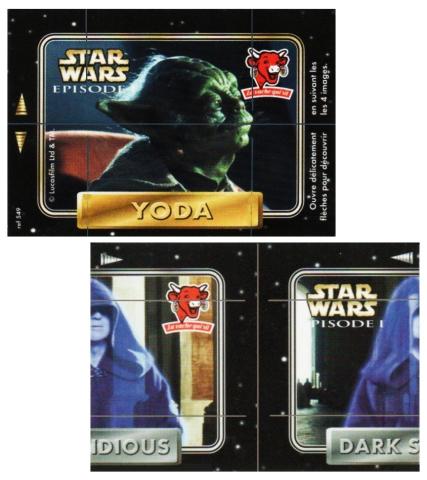
Fromageries BEL [trade : cheese : O/S - France] Star Wars Episode 1 folding cards (2000) -
This is kind of a double date as it were, for today is both the birthday, in 1944, of Frank Richard Oznowicz, and the release, in 1977, of Star Wars.
They are connected in many ways, but mostly by this little chap, Yoda, who was brought to life and to voice by "Frank Oz" in the sequel to "Star Wars, which was called "The Empire Strikes Back" (1980) - plus in, currently, seven sequel films and much other media.
What is less well known is that Frank Oz`s mother and father were puppeteers, and he would often help them out as a child, especially with the smaller puppets. Then he gained an apprenticeship as a teenager, though he really had a hankering to be a journalist.
He may have taken that more serious route, but in 1963 he was offered a job by Jim Henson. His puppets were different, and they told a magical story which would develop into Sesame Street and the Muppet Show.
In fact it was his skill with puppets that led him to George Lucas offering him the part of Yoda.
This card is an odd one, I have puzzled at it for a while and still have not worked out what the folding lines do, but I have enhanced them so you may be able to explain. One side, the Yoda picture is fine, but if you look at the other side it seems impossible to join the two halves together and make the picture whole.
I do have a list of all the subjects in the set though, thanks to a reader. These are :
- Anakin Skywalker
- Obi-Wan Kenobi
- Qui-Gon Jinn
- Yoda
- Queen Amidala
- R2-D2
- Boss Nass
- Jar Jar Binks
- Naboo Fighter
- Royal Naboo Ship
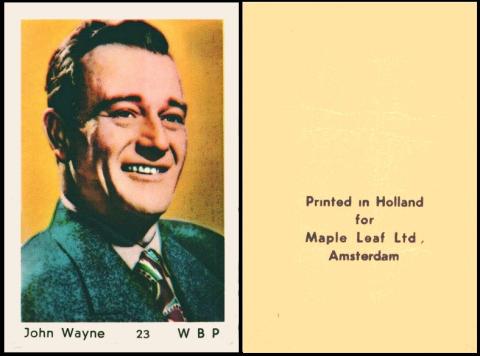
MAPLE Leaf Gum [trade : gum : O/S - Amsterdam, Holland] "Film Stars" (1952) 23/60
This is proving to be a magical mystery tour of the movies as today in 1907 saw the birth of Marion Robert Morrison, who is better known as John Wayne
He was born in Iowa, but grew up in California, where, and you may find this very odd, he fell in love with surfing. However he could not afford a board, and so he started to hang with people who were on the fringe, they used fins to propel themselves out of the water. It was really, dare I say, more skilful than surfing with a board, and our man was hooked. Then there was an accident, and he lost his football scholarship because of it - this seems shrouded in mystery and it is not clear whether he was injured or just discovered on the wrong side of the tracks and punished for it.
Instead of college he started hanging around the movie studios, hoping to pick up work as an extra. It is often said that his first film was "Brown of Harvard" (1926), where, amusingly, he plays a footballer. You can actually watch it for yourself on YouTube - it is about an hour and a half. I am not sure that this is his first film, he may have been hidden in the middle of the crowd for some time before that.
Then, in 1930, he was cast in a western, directed by Raoul Walsh, and called "The Big Trail". It was going to be a huge movie, but it was not so popular with the box office. However it did bring him to the attention of other casting directors for western films, and he made a huge amount of them, until he hit the big time with John Ford`s "Stagecoach" in 1939.
This almost certainly led to him being cast in so many war films, which, when you think about it, were the contemporary equivalent of the western. Many of these were also directed by John Ford,
After the war he continued to make westerns, but also branched out and those films are well worth watching. He was married three times, two of which ended in divorce.He was still married to his third wife when he died in 1979, aged seventy-two.
The first thing that must be told about this card is that "W.B.P." is not the series code, it is simply an abbreviation for the studio, Warner Brothers Pictures.
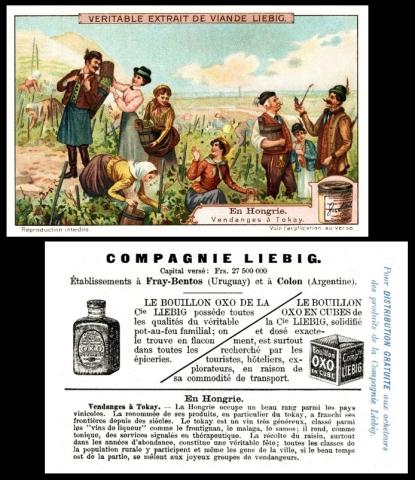
LIEBIG [trade : meat extract : O/S : South America) "En Hongrie" (1911) F.1033 : S.1033
This was the first day where I had to change my mind quickly.
It started out as the first appearance of Batman in 1939, but there is rather a lot of Batman on these pages.
Then it became the opening of the Chrysler building in 1930, but I could not find any cards of that, not even on a New York skyline.
However, just as I was having a whine, one came along and saved me. Solace in a bottle, or so they day. For today is #NationalGrapeDay.
However I must point out, as a non-drinker of alcoholic liquids, that there is more to a grape than booze. They are hyper rich in nutrients and in antioxidants, and, are a good source of fibre, especially if you eat the skins. They have benefits for your heart, blood pressure, eyes, and can also prevent several cancers.
Then I go and find a card relating to the drink, but never mind. This shows Tokay, or, in modern parlance, Tokaji. This change reflects the pronunciation in its native lands of Hungary and Slovakia. In fact, the wine is mentioned in the Hungarian National Anthem. And also, it is so important that out of these six cards showing life in Hungary, the wine manages to feature.
This set is by Liebig, and is called "In Hungary" (F.1033 : S.1033) but it is not to be to confused with another called "The History of Hungary" (S.1681).
The cards in our set show
- Catching wild horses
- At the Fair
- In the cornfields
- The Tokay harvest
- Making beer
- A Hungarian wedding.
And once I get more details I will add them

NESTLE, Peter, Cailler, Kohler [trade : chocolate : O/S : Europe] "Les Mollusques" - Serie. 108 (???)
From the sublime to the ridiculous, they say, but in this case perhaps if we consider Tokay rather a grand wine, it is from the sublime to the slime.
For today is probably the oddest event I have ever featured in these pages, and that is "Slug`s Return From Capistrano Day".
This is an actual day, and a bit of a parody of "Swallows Return to Capistrano Day”, which aims to record the day that the swallows start flying in to the area of San Juan Capistrano in the springtime. Apparently, and this has also been documented, May the 28th is the date when you are supposed to see your first slug. And celebrate it.
Really we ought to give slugs more love. They are maligned by us, and often tortured, by a slow drowning in a mug of beer. I would not wish that on anyone. They are also eaten by birds, frogs, etc, forming a vital, if rather unsavory part of the food chain, especially palatable to young chicks. However they do have another purpose and a pretty important one, for as they go along they take organic matter inside them and pass it through, plus vital nutrients from the inside of their body. Kind of like composting in miniature.
This is a very handsome slug, and if you look you will find others on cards. One of the most intriguing is the snail-slug featured on Wills "Garden Life", card 27. The text tells us it is a "curious and friendly animal [which] does not belong to the same family as the well-known and vegetable devouring slugs (No.45); but is internediate between these and the snails (No.3)"
At which I mut say I have never heard of a snail slug, but, when time permits, I will investigate.

Anonymous / Amalgamated Press [trade : periodicals : UK] "Sportsmen of the World" (1934) – AMA-310 : ZB7-20
Centenary time again, and today sees a hundred years since Alan Cobham set the record for the longest non-stop flight in a light aeroplane. The flight was from Croydon to Zurich in Switzerland, and the aeroplane a prototype of what would become the de Havilland DH.60 Moth biplane. And the return trip took him just under fifteen hours. We know other things too, that it was flown at an average speed of 74.5 mph; and that the cost of the fuel was £4.60...
This was Geoffrey de Havilland`s own aeroplane and he had flown it for the first time in February 1925, at his company airfield, which, younger readers may be surprised to learn, was in modern day Edgware, in London. It was, at that time, unpainted, something which was done within the month.
The main thing about the aeroplane was that it was very light, only one engine, and the fuselage was plywood, covered in cloth. In flight she measured just under twenty four feet across the wings, but for storage they could be folded away, making her just under nine feet wide.
I am saying she but in all there would be eight models that were made before production began, and thirty would be made to test things out as the production went along. After they were satisfied, they produced just under six hundred DH.60s, all in Edgware.
Our craft, G-EBKT, was also flown by Alan Cobham in the Kings Cup Air Race. Then she became a company demonstrator, with limited use by the flying school that was also operated at the factory both to train new pilots and impress visiting dignitaries.
She was sold in 1926, to a lady, who flew her in another race in Paris, but came home next to last. She was then sold, in February 1927, and this is odd, because the buyer`s address is Stag Lane, Edgware, and that is the De Havilland factory, but billed, instead, as the London Aero Club.
Sadly she did not last there too long, she crashed, and was totally destroyed, whilst returning from a flight, not too far from Stanmore, injuring the pilot and his wife who was also on board.
This set might be anonymous, but all is revealed when you find the album. And luckily for us, some of the sportsmen featured in this set were footballers, eight out of the thirty-two cards, so you can read more about it at Football Cartophilic Information Exchange/Amalg.Sportsmen
That let me find it in our British Trade Indexes too. It turns out that it is catalogued in our original British Trade Index part I but at the back of the book, in the Z numbers, in the section for “Cards without reference to commodity or periodical”, as :
SET ZB7-20. SPORTSMEN OF THE WORLD. Sm. 69 x 39. Unnd. (32). Back illustrated at Fig.ZB7-20. Issued in strips of 4 with “The Champion”. Special album issued.
It then lists the sportsmen, so a scan is called for ...
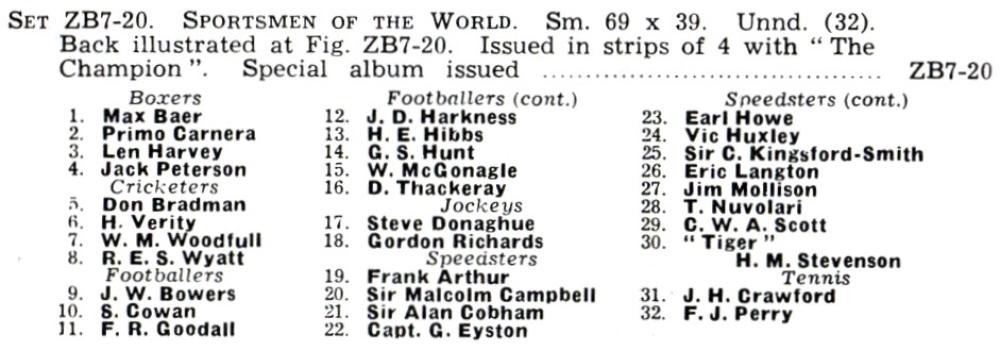
I have to admit, however, that I did not discover this until I got to British Trade Index part II, where it lists it in between AMC-34 and AMC-35. The text there states :
“THE CHAMPION” ALBUM OF SPORTSMEN OF THE WORLD. 20 page album with spaces for 32 cards corner mounted. See set ZJ7-20 in RB.25
In our updated British Trade Index the set has been restored to the Amalgamated stable, and it is catalogued as :
SPORTSMEN OF THE WORLD (C). 1934. 69 x 39. Unnd (32). Issued in strips of 4 or 5, with special album titled “The `Champion`Album of Sportsmen of the World”. Anonymous full text backs. See HA-68.
This HA number refers to the Handbook, but it only lists the cards as I have scanned above, rather than saying which of the cards were strips of four and which in strips of five.
Now five of these complete and uncut strips of four cards are actually shown at the Football Cartophilic Information Exchange/WS, but below them are two rows and a total of eight loose cards, which is kind of confusing. To me anyway.
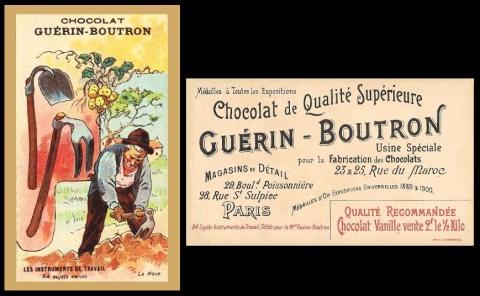
Guerin-Boutron [trade : chocolate : O/S - Paris, France] "Les Instruments de Travail" / "Tools" (1930?)
And lastly, the other card I had to change. It was written down as another centenary, of the election of Gordon Coates as the Prime Minister of New Zealand, but sadly that does not seem to have been featured on any card, any where.
So instead we have the #InternationalDayOfPotato. And I must say I never dreamed of being rescued by a potato, but there you go.
This is a very new event, for it was only in December 2023 that the United Nations General Assembly decided to designate an International Day of Potato, which would take place, for the first time, on May the 30th, 2024.
This year, therefore, is only the second ever event.
However they had good reason, for it is a very healthy food in the nutrition stakes, if eaten in moderation, though to be honest it is the toppings on any jacket potato that are most worrisome. In addition it is easy to grow them at home, in a pot, simply by planting the ones that start to sprout whilst still in your kitchen. Best of all, its simplicity of growing makes it easy to feed many children in rural areas, right across the globe, and the containing it in a pot means that it is unimportant what the soil is like in that locality.
This week's Cards of the Day...
Have been speaking of the North West Mounted Police and their replacement, the Royal Canadian Mounted Police - or the Canadian Mountie, who always gets their man.
Our commemoration records the original North West Mounted Police, which was formed on May the 23rd, 1873. This was then renamed to the Royal Canadian Mounted Police on the 1st of February, 1920.
They were also much more geared to equal opportunities, at least for women, than we were, here in the United Kingdom, and right from the 1890s women were employed as part of the squads, mainly to tackle any females who had offended, (it was pretty rough out there in the wilds), or to console any females who had been offended against. The first woman to move up the ranks and become a constable was Katherine Ryan, or Klondike Kate, who started her job in February 1900. And shortly after that women were employed in the fingerprint laboratories.
In the UK, the first female police constable was Edith Smith, but not until 1915.
Saturday, 17th May 2025
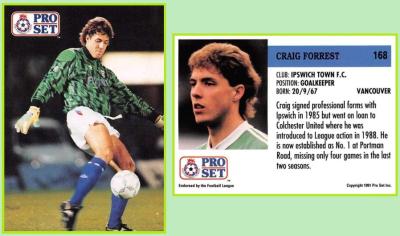
Here we have Craig Forrest, playing for Ipswich Town, but he was born in Coquitlam, British Columbia. He was also a late starter, only standing in as a goalkeeper when another player, his friend, could not attend a match at short notice. He enjoyed the action so much that he decided to play on. Despite his age, for he was already twelve when he first met a football on a field of play, he quickly gained spots on the British Columbia under-sixteen and then under-eighteen teams, during which time he was signed by Ipswich Town for their youth team. Actually they did not have a place for him when they signed him, so he was loaned out to Colchester United.
I have not yet found a card of him there, but we would be looking for 1987-1988 as his "rookie" card, and he stayed with Colchester United for two years before he relocated to Ipswich Town. He would then help Ipswich Town to top the Second Division and gain promotion to the Premier League for the 1992-1993 season. The important fact there is that he was the first Canadian to play in the Premier League.
Despite this, he was loaned to Chelsea in 1996-1997, and signed for West Ham United in 1997. And all through his time in England he was also playing for his national team of Canada. Then, in 2001, he was diagnosed with cancer and had no option but to retire and seek treatment. This was successful, but he decided not to return to the field as a player, but to become a commentator instead.
The link to him and our subject for this week was that British Columbia was not actually patrolled by the North West Mounted Police, they had their own force. However it is certain that in pursuit of their quarry a mountie could possibly have gone across into its borders just a little, especially in the early days, or perhaps, even, been called in as back up, to a larger situation than the local police could handle.
As to why the forces were separate, well this was rather a strange situation, as the original act, passed by Parliament on May 23, 1873, allowed for police to roam the North West Territories; but then, as each of the provinces stepped up and tied themselves to Canada, they were made to agree to police their own borders, rather than tying them to the mounted force already in existence.
Sunday, 18th May 2025
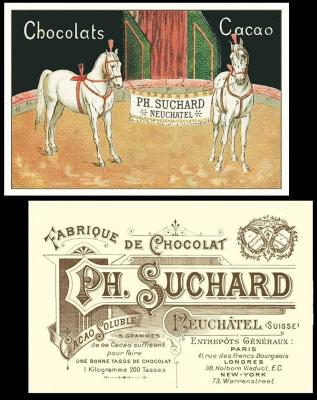
This card gave us the connection with horses, which have always been a very important part of the Royal Canadian Mounted Police.
In the country, a horse allows a rider to chase further, and faster, and also over ground that a person on foot would struggle, with the ability to leap over any obstacles that block their path. Whilst in a town or encampment, they are taller than any crowd, more physically imposing, and it is harder for anyone to grab their weaponry - but also anyone in need of assistance can spot them and head towards. There is another benefit too, in a crowd, for being on horseback allows the rider to see above the heads of the crowd, to survey the scene in a wide angle and to hone in to spot anyone heading towards them whose intentions may not be honourable, then to reach down and unarm them.
It is not true that the North West Mounted Police were the first mounted crime fighters though - that honour goes to the Marechausee, or marshals, in France way back in the middle ages. There is also reason to give the credit to the Romans, who also had men patrolling on horseback, keeping order, but were not technically part of a regulated police force as we know today.
The Australian `New South Wales Mounted Section of the Police` also deserve a mention, as they began on the 7th of September 1825, and thus are the oldest mounted police to remain to this day in a more or less unaltered, and never stood down, form.
Mounted police units were used in Canada before the inception of a special service, from the early nineteenth century, but they were not banded together as a central force. In fact, very often, they were one man bands, with no back up. The joining together, and standardisation of rules, only happened in 1873 with the founding of the North West Mounted Police. And it soon spread to other areas, the first two of which were Montreal in 1885, and Toronto, in 1886.
You will notice there is nothing about our card. I suspect it to either be a one off, or part of a set of "Circus scenes", but have not managed to track it down. if you know it, please get in touch with us.
Monday, 19th May 2025

This gave us the final element, the police. Though I imagine this poor chap would have a much less pleasant working environment than his Canadian counterparts. No wonder he looks a bit glum.
If he had thought about it though, he could have joined a British mounted police squad, for there had been one, since October 1763, called The Bow Street Horse Patrol. These were, surprisingly, not policemen, but they were formed directly to combat highwaymen, and were a night force only. To begin with there were less than ten men, and they were each given a sword, a pistol and a club, which would develop in size and name into becoming a truncheon. They were a development of the Bow Street Runners, the first UK police force, but they had no jurisdiction in London, they could only apprehend the highwaymen from its outskirts, along the turnpike roads. After a year the grant to support them was stopped and they disbanded, all but two men, who were presumed to be of use to Bow Street Magistrates Court, should a felon abscond on the way to their proceedings. However, in 1805 a mounted patrol was started again, mainly because in their absence highwaymen had again swelled in number. This incarnation saw about fifty men but again they were only to patrol outside London, after dark, and they often reached right down into the Home Counties and back in one night`s patrol. They also had a new uniform, a red waistcoat under a blue greatcoat.
Then, in 1839 this patrol became part of the Metropolitan Police, as their mounted branch.
This set is first described by us in our original reference book to the issues of W. & F. Faulkner, RB.1, which was published in 1942. The listing is as follows :
- 1899. 12 POLICE TERMS (untitled series). Size 2 3/4" x 1 1/2". Unnumbered. Fronts, lithographed in colour, no marginal lines. "Terms" below subject. "Grenadier Cigarettes, " "W. & F. Faulkner Ltd., London, S.E." below subjects, in black. Backs plain. Printed by A. Hildesheimer & Co. Subjects numbered here for convenience ; -
- A Smart Capture.
- Guardian of the Peace.
- Investigating a Mystery.
- On The beat.
- One of the best.
- Pass along, please.
- Point Duty.
- Police Court.
- Rabbit again
- Stop thief
- The thin blue line.
- Where duty calls,
The H.165 link takes us to the original London Cigarette Card Company Catalogue and Handbook for 1950, however it merely links to the above, saying :
- H.165. POLICE TERMS (Faulkner) - See Society Booklet No.1 page 10
By the time of our original World Tobacco Issues Index the entry has been reduced, to
- POLICE TERMS. (A). Unnd. (12). See Ha.165 ... F14-12
This is virtually the same in the updated version, but the handbook link and card code are altered, to :
- POLICE TERMS. (A). Unnd. (12). See H.165 ... F150-270
This handbook is ours, but it alters the numbering system, moving "A Smart Capture" to position 10 instead of position 1. Unfortunately that then re-numbers cards one to nine as well. Which is a little reminder that you should always write the name of the card on the wants lists you send to dealers, and not just quote a number from the reference books.
The full text is :
- H.165 POLICE TERMS (adopted title). Fronts in colour. Issued by Faulkner. Unnumbered series of 12 ; -
- Guardian of the Peace.
- Investigating a Mystery.
- On The beat.
- One of the best.
- Pass along, please.
- Point Duty.
- Police Court.
- Rabbit again
- A Smart Capture.
- Stop Thief.
- The thin blue line.
- Where duty calls,
Tuesday, 20th May 2025
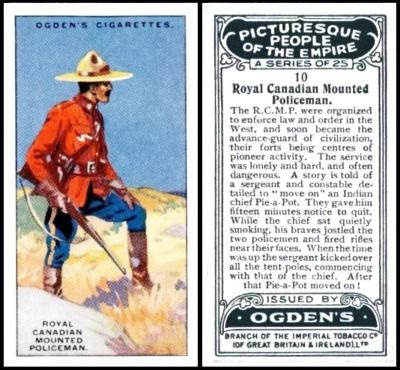
So here we are in the 1920s. And I have been waiting to use this card for a while - in fact it is the reason for this week`s theme. As to why, well, it is another complex set with several issuers, too many to have as a newsletter card, but also they require scrolling, whilst cards of the day provide a direct link.
I also believed it to be the earliest card of a "Mountie" in existence, but I have been told that is incorrect, for in 1901 Cohen Weenen & Co. had one in their "Home and Colonial Regiments", as part of the `100 Series`, which you can see as part of the George Arents Collection at the New York Public Library
By the time our card was issued the North West Police was no more, and the Royal Canadian Mounted Police had taken their place. That happened in 1920, with the joining together of the assorted Dominion police forces and the North West Mounted Police.
There is another unusual fact that I have not yet mentioned though, as though they are concerned with protection and legality, their legislation describes them as "peace officers", not "police officers"
This set is actually first recorded in our original Ogden`s reference book, RB.15, first issued in 1949, as :
- 131. 25 PICTURESQUE PEOPLE OF THE EMPIRE. Fronts lithographed in colour. Backs in grey, with descriptive text. Home issue, 1927. Similar series issued by B.A.T., Player, United Tobacco Co. (South Africa) and Wills.
It is then mentioned in our reference book RB.16 – The Cigarette Card Issues of W.D. & H.O. Wills Parts I, II, and III (revised) and Part IV, published in 1950, as :
- 288. 25 PICTURESQUE PEOPLE OF THE EMPIRE. Fronts printed by letterpress in colour. Backs in grey, with descriptive text. Issued in New Zealand, between 1925-1930. Similar series issued by Ogden, Player, and United Tobacco Companies, (South) Ltd., South Africa.
There are two important things about this.
The first is that the Wills version was produced by a different printing method to our Ogden`s set. This may lead you to think that the Wills version was produced locally overseas before being circulated, but this is incorrect, as the printing date appears in the list supplied to us by Messrs W.D. & H.O. Wills, namely November 1928. And this was a list of all sets printed in the UK and exported for distribution.
And the second is that the mention of a fifth version, by B.A.T., has already been removed.
The next version to feature in a reference book is the one by John Player, in RB.17, also published in 1950. That reads :
- 147. 25 PICTURESQUE PEOPLE OF THE EMPIRE. Small cards. Fronts in colour. Backs in grey, with illustration of `Drumhead` packet, Overseas issue, October 1928. Similar series issued by Ogden, Wills, and United Tobacco Co`s,South Africa.
Sadly they do not mention the printing process at all. But it is curious that this version was issued before the Wills one.
The last time it appears in one of our early, small reference books, it is a round up, as part of RB.17, covering the issues of the British American Tobacco Company, which was published in 1952. That reads :
- 200-288 PICTURESQUE PEOPLE OF THE EMPIRE. The recordings in W/288, RB.15/131 and RB.17/147 are summarised below.
A. Wills` Overseas issue
B. Player Overseas issue, with `Drumhead` cigarettes.
C. U.T.C. issue
D. Ogden Home issue.
It is in the front index of this book that we discover the countries of issue - Wills being "1928 - New Zealand", Player being "1938 - Malaya and Siam", U.T.C. being "1929". Ogden`s version, being a home issue, and nothing to do with British American Tobacco, does not appear in the index.
In our World Tobacco Issues Index these sets are again parted. Our Ogdens version can be found under section 4, for "Issues with I.T.C. Clause. All issued in U.K. Small size 67 x 36 unless stated", and sub-section 4.B, for "Issues 1922-39", as :
- PICTURESQUE PEOPLE OF THE EMPIRE. Sm. Nd. (25). See RB.21/200-288.D ... O/2-164.
This text remains the same in our updated World Tobacco Issues Index, but there is a new card code, of O100-550
As for the other issuers, their issues are recorded in the World Tobacco Issues Indexes as :
John Player :
original W.T.I. - under section 3, for "Export issues without I.T.C. Clause, issued through B.A.T.", and sub-section 3.B, for "Issues 1923-30. Chiefly in New Zealand, Malaya and Siam" as :
- PICTURESQUE PEOPLE OF THE EMPIRE. Sm. Nd. (25). See RB.21/200-288.B ... P72-196.
updated W.T.I. - under section 4, for "Export issues without I.T.C. Clause, issued through B.A.T.", and sub-section 4.B, for "Issues 1923-30. Chiefly in New Zealand, Malaya and Siam. Small size 67-68 x 35-36, unless otherwise stated" as :
- PICTURESQUE PEOPLE OF THE EMPIRE. Sm. Nd. (25). See RB.21/200-288.B ... P644-632
The United Tobacco Companies (South) Ltd :
original W.T.I - under section 2, for "Issues 1918-43" and sub-section 2.A, for "Cards in English only" - as opposed to "Cards in English and Afrikaans", as :
- PICTURESQUE PEOPLE OF THE EMPIRE. Sm.67 x 36. Nd. (25). See RB.21/200-288.C ... U14-26
updated W.T.I - under section 2, for "Issues 1918-43" and sub-section 2.A, for "Cards in English only" - as opposed to "Cards in English and Afrikaans", as :
- PICTURESQUE PEOPLE OF THE EMPIRE. Sm.67 x 36. Nd. (25). See RB.21/200-288.C ... U560-510
W.D. & H.O. Wills :
original W.T.I - under section 5, for "Other Export issues" and sub-section 5.B, for "English Language Issues, 1923-30. Issued chiefly in New Zealand, some series in Malaya, Malta, and elsewhere", as :
- PICTURESQUE PEOPLE OF THE EMPIRE. Sm. Nd. (25). See RB.21/200-288.A ... W62-463
updated W.T.I - under section 6, for "Other Export issues" and sub-section 6.B, for "English Language Issues, 1923-30. Issued chiefly in New Zealand, some series in Malaya, Malta, and elsewhere", as :
- PICTURESQUE PEOPLE OF THE EMPIRE. Sm. Nd. (25). See RB.21/200-288.A ... W675-665
Wednesday, 21st May 2025
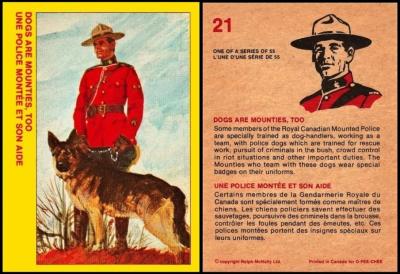
Here we are in 1973, marking the Centenary of the founding of the North-West Mounted Police / Royal Canadian Mounted Police, on May 23, 1873.
There had been many changes in that time, and one of the largest had come just one year after our last card had been issued, for in 1928 the Royal Canadian Mounted Police had seen themselves come more under the control of the government than ever. However it turned out that this was a good thing, as it freed the supervisors and men to devote more time to the actual policing and less to the paperwork and regulations, which were contracted out to the council.
Many of the incidents of the intervening years are recorded here, though it is not in chronological order. It speaks of their encounters, and often battles, with the Native Americans, plus the Cypress Hills Massacre of 1873 - which was really the catalyst to increase recruitment to the new force - the policing of the goldfields at Klondyke as they expanded and grew more lawless, the "Long March West", the arrival of the Canadian Pacific Railway, the introduction of the St. Roch - a vessel that allowed them to patrol into the Arctic - and their gaining even more height than a horse could provide, with the introduction of aircraft and helicopters.
This set was specially produced by O-Pee-Chee to celebrate the centenary, and it was only available in Canada, which has led to its scarcity over here today. If it had been more universally circulated perhaps the text would have had space to expand, as it is restricted by its bi-linguality. Yet, it is a strange set, with many omissions.
It does not mention their reluctance to make the force multi-cultural, until the arrival, in 1969, of officer Hartley Gosline, fulfilling his childhood dream to be a "Mountie", despite many obstacles from other members of the squad and of the general public. He eventually left them in 1978. However, today we recognise his strength and fortitude, and many "Mounties" like him cite him as their role model, for, and thankfully, today we live in more enlightened times.
There is also nothing about the trouble they had with spying from the Soviet Union just after the Second World War - and not even the breaking off of a Special Branch, which that caused, shortly before this set arrived.
No word, either, of Labrador and Newfoundland joining Canada, in 1949.
And no mention of the force becoming part of Interpol in 1953 (though at that time it was called the rather clunkier "International Criminal Police Organization").
Now the cards were distributed in waxed packets of eight cards, plus bubble gum, and they cost ten cents each. Each card has a large head of the Mountie in the corner, whilst in the opposite corner it says "One of a series of 55". They all have yellow borders to the front, and they are a mixture of action cards which tell the story of the force, with a few portraits, all drawn, namely :
- Sitting Bull
- Chief Big Bear and Little Bear
- Commisioner George Arthur French
- Scout Jerry Potts
- William Butler
- Chief Poundmaker
- Crowfoot
- Superintendent Sam Steele
Or that was what I thought when I uploaded this on Wednesday morning......
Thursday, 22nd May 2025
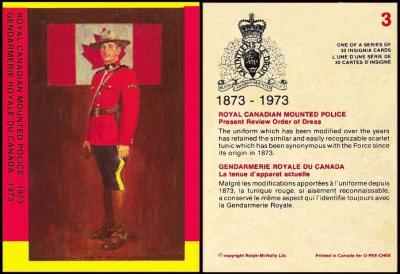
On Wednesday, I was sent this scan, and the information that there was a second set, of which one card was inserted in each packet, along with seven cards of yesterday`s set.
It does not mention this anywhere on the card, only on the wax packet, in an inset box which reads "Extra in every pack Uniform or Insignia card..." And this packet also gives the correct name of the set, which is now altered on yesterday`s and today`a headers.
If you look closely at this card there are ways to spot it is two sets - but only if you have both. This "Insignia" set does not have the large head of the Mountie in the corner, instead there is a badge below which is "1873-1973", and in the opposite corner it says "One of a series of 30 Insignia Cards". Despite this, they have become pretty universally known as "Emblem Cards"
They are easy enough to spot from the front, as each card shows a different RCMP insignia, each on a red background, with yellow borders to top and bottom only.
However, the set actually begins with three portrait cards, the last of which we show as out card of the day for today, and these are :
- North West Mounted Police - 1874
- North West Mounted Police - 1898
- Royal Canadian Mounted Police - 1973
Now these are often wrongly thought to be part of yesterday`s set, by collectors who have not noticed that this is a set of only thirty cards, and believe that their first three cards tell the history of the uniform.
The packet does not really help this either; it neither says that the "uniform or insignia card" is from a second set, nor makes it clear that there are other cards in that second set that actually show the insignia on its own.
And it does not help that yesterday`s set is not in chronological order.
Friday, 23rd May 2025
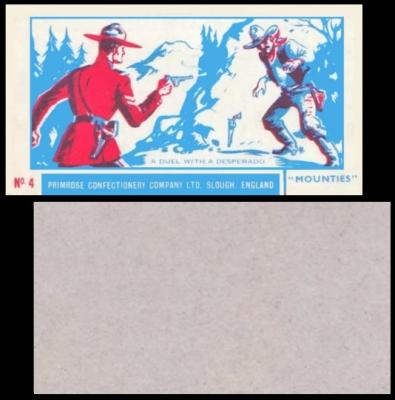
This set was aimed at children, and so it seems a good idea to close the week by speaking of "Mounties" in popular culture.
The first film I have tracked down is "Border River", released in 1919 It starred Evelyn Brent and Ben Hendricks Jr. as a brother and sister caught up in smuggling and bootleg liquor, who are apprehended by a "Mountie", though sadly the person who played him seems not to have been recorded.
The film led to several other "Mountie" features in the 1920s. First of all was one with William S. Hart, forsaking his cowboy garb for once, to play [Sergeant[ "O`Malley of the Mounted". Like that film, most dealt with a "Mountie" infiltrating a gang to find a miscreant and bring them to justice. Between 1921 and 1929 no fewer than eleven films trod this path, some bringing in inclement weather, and maidens in peril of Native American attack, or alternatively featuring a character who is made to join the force to atone for some misdeed, and finds not only redemption but a better way of life. Early in the 1930s, a reversal of this idea found Buck Jones as "McKenna of the Mounted", a "Mountie" gone bad, embroiled and in debt to gambling, who becomes a highway robber, and even attempts to steal from his ex girl`s family, though I expect it all turns out okay in the end.
The 1930s saw the force appearing in a musical "Rose Marie" (1936), being joined by Shirley Temple as "Susannah of the Mounties" in 1939, and being made the brunt of several jokes by the Crazy Gang in "The Frozen Limits" (also 1939). There were also many films following the former, familiar themes from the 1920s. And they continued to be made right through the Second World War, bringing in the Japanese and the Germans. In 1943, even Errol Flynn was a "Mountie", in "Northern Pursuit", assigned with capturing an important member of the Luftwaffe, who had escaped from a prisoner of war camp in Canada.
That was the last film for a while, until 1946, when Tex Avery made "Northwest Hounded Police", starring "Droopy" as Sergeant McPoodle, charged with capturing the wolf, who had escaped from Alka-Fizz prison.
In the mid 1950s, you can tell that television is making inroads, and in 1954 "Gunfighters of the Northwest" was the last "Mountie" film of the traditional form. That starred Jock Mahoney (aka The Range Rider) and Clayton Moore (aka The Lone Ranger). They did make a come back in the 1980s and 1990s, but usually involving aliens and/or excessive violence.
Instead, the old ways went to television, and to "Sergeant Preston of the Yukon", based on a radio show called "Challenge of the Yukon", which had started way back in 1938. The television version starred Richard Simmons, and it only ended in 1958.
It was replaced by "R.C.M.P.", which also, amazingly, used actual cases as the background for some of the shows, including some which were on the unsolved list. That lasted until 1960, but though popular with many it suffered from the fact that the American networks consistently wanted to add more guns and violence and the writers wanted to follow the true nature of the Royal Canadian Mounted Police, where such things happen seldom.
After that there were no actual tv shows with a "Mountie" as the hero. The closest was "McCloud", who would very occasionally wander up north of the border and get involved in their cases. That lasted until 1977.
After another brief hiatus, along came a very popular series called "Due South", which ran for six years, between 1994 and 1999 and starred Paul Gross as the "Mountie", who comes to Chicago to try and track the killers of his father and teams up with a local policeman played by David Marciano. It was a mixture of comedy and sadness, and it certainly was popular. Then it all ended, with our hero returning to Canada - though, pleasingly, it ends on a cliff hanger, from where it was hoped to continue. Though, sadly, that never took place.
Our cards seem to be related to the British screening of the television series "R.C.M.P." and there were other spinoffs too including a children`s book. In addition we know that though the series was Canadian it was a co-pro with the Australian Broadcasting Corporation and the British broadcasting Commision. One of the writers was also Vincent Tilsley, of the BBC. And it was shown on the BBC, from July 1960, but only for one season, just short of forty episodes. And our set was issued in that same year.
The set appears in our original British Trade Index part two, RB.27, published in 1969, as :
- "MOUNTIES". Package design, about 70 x 37 when cut. Red and blue. Nd. (22). No album ... PRI-10
Our updated volume, printed in 2000, alters this slightly, to
- "MOUNTIES". 1960. 70 x 45, uncut. Packets, for Sweet Cigarettes. Red and blue. Nd. (22). No album ... PRI-250
Though dotted lines were printed on the packets, to aid cutting, these were not always followed very well, for this was a product aimed at children, whose skill with scissors leave a lot to be desired; that was if they did not just tear the card off, because it was actually the entire back section of the packet, with the side edges of the card to the top and bottom of the packet, and the top and bottom of the card being joined to the rest of the packet.
By the way, on one side of that packet it gives the ingredients - "Sugar, Corn Syrup, Corn Starch, Hardened Palm Kernel Oil, Gelatine, Certified Artificial Flavours and Colours".
And so, dear readers, we come to the end for another week, which has been an exciting one in many ways.
But I must close, for I am off to Woking in just a few hours time, via several buses and trains, and with a walk at the end towards the Leisure Centre from the station. Last time I did that last bit by bus, but though I asked them to let me off at the Leisure Centre they forgot, and I failed to notice, and I had to walk some way to return. However now I know the proper, and quicker, way to walk it will take me but minutes.
And if you are going, do say hi.
